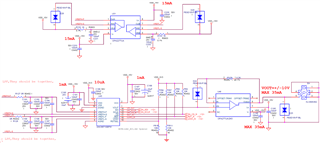Other Parts Discussed in Thread: DAC8871
Hello:
In the process of using TI's operational amplifier chip opa2277ua and DAC chip dac8871, it is found that the operational amplifier chip opa2277ua has serious heating, with the temperature as high as 80 ~ 90 ℃. Please see if it is normal. At present, the following work has been done (the schematic diagram is attached at the end):
Note: the system is powered by 12V, and the required voltage is converted. Ni represents that the device is not welded.
1. Chip working voltage + 15V, - 15V, + 10V, - 10V, 3.3V oscilloscope test is normal;
2. After the system is powered on, the Vout of DAC is measured as 0V;
3. D28 and D29 have been removed;
4. Remove the resistor r127 in vrefh-f network, the total current of the system is reduced from 0.31a to 0.27A, and the temperature of opa2277ua is reduced to about 60 ℃. Remove the resistor r128 in vrefl-f network, the total current is reduced to 0.24a, and the temperature of opa2277ua is reduced to about 30 ℃.


